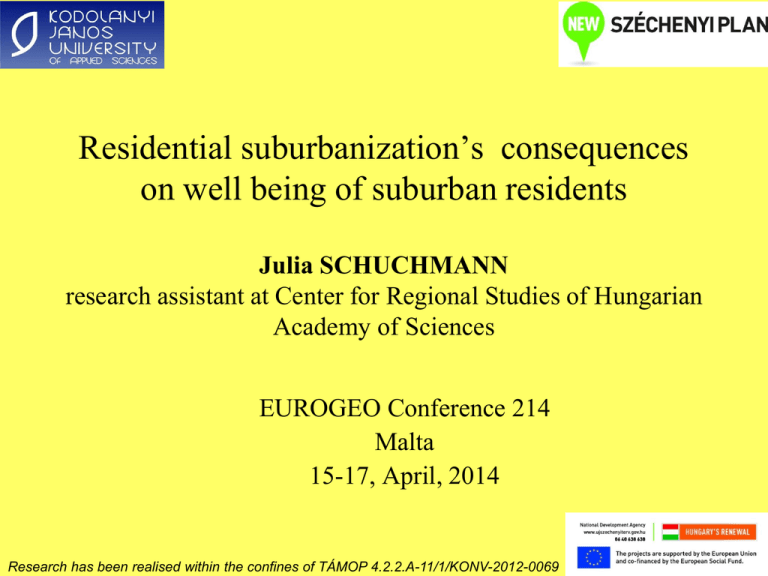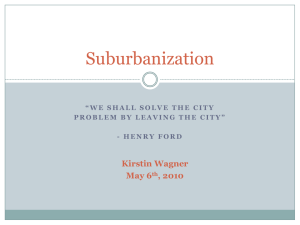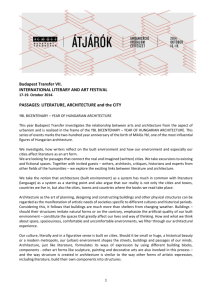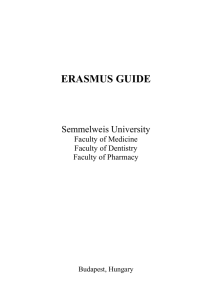Residential suburbanization`s consequences on well being
advertisement

Residential suburbanization’s consequences on well being of suburban residents Julia SCHUCHMANN research assistant at Center for Regional Studies of Hungarian Academy of Sciences EUROGEO Conference 214 Malta 15-17, April, 2014 Research has been realised within the confines of TÁMOP 4.2.2.A-11/1/KONV-2012-0069 Two aims of this lecture are: • To present the characteristics of residential suburbanization processes in the Budapest Metropolitan Region during the last two decades • To analyze the consequences of residential suburbanization on social well being of inhabitants in the Budapest Metropolitan Region based on empirical research results Methodology 1.) International and Hungarian scientific literatures regarding the residential suburbanization and well being issues 2.) Analisis datas from two big empirical research projects: – Sustainable Consumption Production and Communication„ The social mechanism and interest determining consumption models. The model of sustainable consumption” supported by the Norwegian funds, coordinated by the Institute of Sociology Hungarian Academy of Sciences, and organized by the Corvinus University.Project Leader: Prof. Viktoria Szirmai, Dsc. – Social conflicts-social well being and social security. Competitivity and social development TÁMOP 4.2.2.A-11/1 KONV-0069 (2013-2015). Research project Leader: Prof. Dr. Szirmai Viktória Short introduction of Budapest Metropolitan Region • Budapest and its metropolitan area occupies only 3,3 % of the countries whole territory but: • It concentrates the 25% of total population of Hungary (2,2 million inhabitants) • The economic role of the BMR within the country is dominant: • Here produces the 4 % of the national GDP • The amount of GDP/capita in the BMR is 1,8 higher than the national average • The BMR is the only urban region with over 1 million inhabitants Characteristics of residential suburbanization in the Budapest Metropolitan Region • The urban development and suburbanisation are delayed in time comparison to the Western European cities but has the same urban economic and soial features (Enyedi, 1988; Enyedi 212.) • The suburbanisation started in 1980 with a 20 years delay and intensified in the 90’s. • The process was helped by the development of free real estate market, the effects of globalization, social change and economic policy • During the last 20 years socio-economic relations between capital city and outskirt areas have changed. • Residential migration was remarkable from Budapest to suburban municipalities but from 2OO7 a slow return to the city centre (a kind of reurbanisation) has been emerged due to the inner cities rehabilitation programs • The residential suburbanization were differentietd by social and spatial Negatives consequences of residential suburbanization on the well-being of suburban population a.) Social consequences: It contributes to the increasing of the social-spatial inequalities It contributes to the social segregation and exclusion (e.g „gated commutnities”) It contributes to generate social conflicts (between former citizens and rural peoples) The suburban lifestyle is quite „closed”, because of the commuting the peoples don’t have time to participate in the communities Risques of obesity, and car crash ( car based lifestyle) B.) Environmental consequences Wasteful land usage-decreasing green areas, growing build up areas Increasing volume of car usage and number of private cars=>contribution to the CO2 emission c.) Economic consequences The suburban lifestyle charges the housholds (higher transport costs) on the one hand and the central and local governement ( infrastructural development costs) on the other hands The notion of the well-being • Well-being is a general term to describe the social, economic, mental or health status of an individual or a group. We distinguish two types of well beingobjectives and subjective well being. • How the suburbanization influences of the residents well-being? Answers based on hungarian empirical research results about the Budapest Metropolitan Region Changes in the Intention to move in the Budapest Metropolitan Region, 2005, 2010, 2014 N=1000 • Hogyan kapcsolódik 77 80 össze a lakóhelyi 70 szuburbanizáció 100 86 90 83,5 60 50 40 30 15 20 10 8,8 10 0 2OO5 2O1O Want to move Source: don't want to move 2O14 Evaluation of the social segregation by the respondants in Budapest and its agglomeration area, 2014 (N=1000) 12,0 10,4 10,0 8,0 5,4 6,0 4,0 2,0 0,0 Budapest agglomeration How your life influences by the stress ? (Scaling from 1-4) (1= not at all; 4=very stressful) N=1000 50 47 45 40 40 35 32 31 30 25 20 18 16 15 10 10 6 5 0 not in the least a little bit Budapest moderate Metropolitan region very stressful How often do you commute? N=1000 0,5 4,3 5,3 50,9 39,0 less than a months weekly daily several times per months several times per week What is your problem with the commuting? N=1000 60 54,2 50 40 31 30 26 20 14 10 0 less time with my family and friends too expensive less time to go out less time for cultural activities Residents indebtedness in the Budapest Metropolitan Region, 2014 N=1000 35 32 30 25,2 25 20 20 15 10 5 0 Budapest agglomeration Sample average Conclusions During the last two decades one of the most spectacular urban development trend was the residentuial suburabanization which transformed the social spatial structure of Budapest Metropolitan Region The residential suburbanization has several social, environmental and economic consequences on the well- being of the residents in terms of social conflicts, problem of transportation etc. Based on the empirical research results between 2005, 2010, 2014 the intention to move has decreased in the Budapest Metropolitan Region because of the effects of the global economic crisis. Thank you for your attention!











